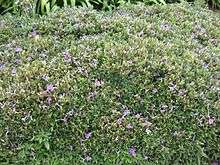Ruellia
| Ruellia | |
|---|---|
 | |
| Ruellia tuberosa | |
| Scientific classification | |
| Kingdom: | Plantae |
| (unranked): | Angiosperms |
| (unranked): | Eudicots |
| (unranked): | Asterids |
| Order: | Lamiales |
| Family: | Acanthaceae |
| Subfamily: | Acanthoideae |
| Tribe: | Ruellieae |
| Genus: | Ruellia L.[1] |
| Species | |
|
Many, see text | |
| Synonyms | |
|
Aphragmia Nees | |
Ruellia is a genus of flowering plants commonly known as ruellias or wild petunias.[2] They are not closely related to petunias (Petunia) although both genera belong to the same euasterid clade. The genus was named in honor of Jean Ruelle, herbalist and physician to Francis I of France and translator of several works of Dioscorides.
Apart from the numerous formerly independent genera nowadays considered synonymous with Ruellia, the segregate genera Blechum, Eusiphon, Polylychnis and Ulleria are often included in Ruellia. Acanthopale, however, is considered a distinct genus.
Ruellias are popular ornamental plants. Some are used as medicinal plants, but many are known or suspected to be poisonous. Their leaves are food for the caterpillars of several Lepidoptera (butterflies and moths), typically Nymphalinae and in particular members of their tribe Junoniini. Nymphalinae using Ruellia as host plants include the common buckeye (Junonia coenia), recorded on R. nodiflora, the lemon pansy (Junonia lemonias), recorded on R. tuberosa, and the malachite butterfly (Siproeta stelenes) and Australian lurcher (Yoma sabina), which are recorded on several species.

_in_Talakona_forest%2C_AP_W_IMG_8317.jpg)

Selected species
|
|
Formerly placed here
Numerous plants, mainly Acanthaceae, are former members of Ruellia. Some examples are:
- Asystasia gangetica subsp. micrantha (Nees) Ensermu (as R. intrusa Forssk.)
- Asystasia gangetica subsp. gangetica (as R. zeylanica J.Koenig ex Roxb.)
- Blepharis ciliaris (L.) B.L.Burtt (as R. ciliaris L. or R. persica Burm.f.)
- Dyschoriste oblongifolia (Michx.) Kuntze (as R. oblongifolia Michx.)
- Hemigraphis repanda (L.) Hallier f. (as R. repanda L.)
- Hygrophila costata Nees et al. (as R. brasiliensis Spreng.)
- Hygrophila difformis (L.f.) Blume (as R. difformis L. f.)
- Hygrophila lacustris (Schltdl. & Cham.) Nees (as R. lacustris Schltdl. & Cham.)
- Hygrophila ringens (L.) R. Br. ex Steud. (as R. ringens L. or R. salicifolia Vahl)
- Lepidagathis alopecuroidea (Vahl) R. Br. ex Griseb. (as R. alopecuroidea Vahl)
- Lindernia antipoda (L.) Alston (as R. antipoda L.)
- Stenandrium dulce (Cav.) Nees (as R. dulcis Cav.)
- Strobilanthes anisophylla (Lodd. et al.) T. Anderson (as R. anisophylla Lodd. et al.)
- Strobilanthes hamiltoniana (Steud.) Bosser & Heine (as R. hamiltoniana Steud.)[4]
- Teliostachya alopecuroidea Nees (as R. alopecuroidea, R. alopecuroides)
See also
- 21540 Itthipanyanan, an asteroid named after a student who authored an award-winning experiment[5] on the dehiscence and dispersion of Ruellia tuberosa seed pods.
References
- ↑ "Genus: Ruellia L.". Germplasm Resources Information Network. United States Department of Agriculture. 2009-01-23. Retrieved 2010-05-26.
- 1 2 "Ruellia". Integrated Taxonomic Information System. Retrieved 2011-05-20.
- ↑ "Ruellia ciliosa Pursh". Integrated Taxonomic Information System (ITIS). Retrieved 6 April 2013.
- 1 2 "GRIN Species Records of Ruellia". Germplasm Resources Information Network. United States Department of Agriculture. Retrieved 2011-05-20.
- ↑ "21540 Itthipanyanan (1998 QE11)". JPL Small-Body Database. Jet Propulsion Laboratory. Retrieved 6 April 2013.
External links
| Wikimedia Commons has media related to Ruellia. |
| Wikispecies has information related to: Ruellia |
| Wikisource has the text of the 1920 Encyclopedia Americana article Ruellia. |
- Germplasm Resources Information Network: Copioglossa
- PlantSystematics: Ruellia
- Classification: Ruellia, species list at USDA Natural Resources Conservation Service
- Tree of Life: Ruellia.